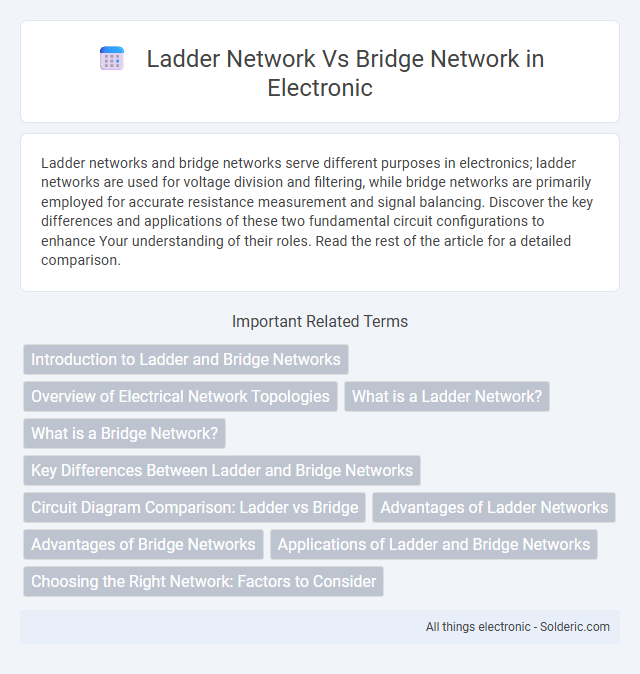Ladder networks and bridge networks serve different purposes in electronics; ladder networks are used for voltage division and filtering, while bridge networks are primarily employed for accurate resistance measurement and signal balancing. Discover the key differences and applications of these two fundamental circuit configurations to enhance Your understanding of their roles. Read the rest of the article for a detailed comparison.
Comparison Table
| Feature | Ladder Network | Bridge Network |
|---|---|---|
| Purpose | Semi-supervised learning with robust feature representation. | Enhanced deep learning with efficient parameter usage. |
| Architecture | Encoder-decoder with lateral skip connections at each layer. | Multiple parallel paths connecting layers, enabling feature reuse. |
| Skip Connections | Lateral connections between encoder and decoder layers. | Bridging connections that link non-adjacent layers. |
| Training Method | Combines supervised and unsupervised losses for denoising autoencoding. | Primarily supervised training with improved gradient flow. |
| Use Cases | Image recognition, semi-supervised classification tasks. | Deep networks requiring efficient information flow and reuse. |
| Advantages | Improves generalization by leveraging unlabeled data. | Reduces vanishing gradient issues, enhances model capacity. |
| Limitations | Complex training procedure, requires careful hyperparameter tuning. | Increased architectural complexity, may require more computation. |
Introduction to Ladder and Bridge Networks
Ladder networks consist of series and shunt elements arranged to create low-pass filter characteristics, commonly used in impedance matching and signal filtering applications. Bridge networks feature a configuration of resistors or reactive components forming a bridge circuit, mostly applied in measurement and sensor circuits for accurate detection of imbalance. Both topologies serve crucial roles in analog circuit design, optimizing performance in signal processing and measurement tasks.
Overview of Electrical Network Topologies
Ladder networks consist of repeating series and parallel components arranged in a step-like structure, commonly used for impedance matching and filter design due to their predictable voltage and current distribution. Bridge networks form a diamond-shaped configuration with four branches and are essential for precise measurement and balancing circuits, such as the Wheatstone bridge for resistance measurement. Understanding these topologies helps you optimize circuit performance and accuracy in analytical and signal processing applications.
What is a Ladder Network?
A Ladder Network is an electrical circuit configuration that consists of repeating units of series and parallel resistors resembling the rungs and sides of a ladder, commonly used for precise resistance measurements and signal processing. This network provides predictable impedance characteristics and voltage drops, making it ideal for applications like digital-to-analog converters and waveform synthesis. Understanding the structure and function of Ladder Networks can help you optimize circuit design for improved accuracy and performance.
What is a Bridge Network?
A bridge network is a type of Docker network that allows containers connected to the same bridge to communicate with each other as if they were on the same physical network, providing isolation from external traffic. It operates at the data link layer (Layer 2) and uses network bridge technology to connect multiple network interfaces, enabling seamless container communication through automatic IP address assignment via Docker's internal DHCP. This network type is the default in Docker, offering simplicity and security for container interactions within a single host environment.
Key Differences Between Ladder and Bridge Networks
Ladder networks feature a series of repeated series and shunt components that create a predictable impedance pattern, commonly used in filter designs for signal processing. Bridge networks, such as the Wheatstone bridge, utilize a closed-loop configuration with four resistive arms to precisely measure unknown resistances or balance circuits. The key difference lies in ladder networks optimizing signal filtering through cascaded stages, while bridge networks emphasize accurate measurement and comparison of electrical quantities.
Circuit Diagram Comparison: Ladder vs Bridge
The ladder network circuit diagram features a series of repeating units resembling the rungs and side rails of a ladder, typically consisting of resistors arranged in cascaded series and parallel configurations. In contrast, a bridge network circuit diagram forms a closed loop with four arms, where resistors or impedances create two voltage divider paths that can be balanced for precise measurements. Understanding the distinct layouts in your circuit design can optimize signal accuracy and impedance matching for applications like sensing and filtering.
Advantages of Ladder Networks
Ladder networks offer superior noise reduction and feature extraction capabilities compared to bridge networks, making them ideal for complex signal processing tasks. Their architecture supports efficient autoencoding and semi-supervised learning, enhancing model accuracy with fewer labeled data. You can leverage ladder networks to improve robustness and generalization in various machine learning applications.
Advantages of Bridge Networks
Bridge networks offer superior scalability and flexibility compared to ladder networks, accommodating complex circuit designs with fewer components. They enable precise measurement of electrical parameters, such as resistance, capacitance, and inductance, enhancing accuracy in sensor and testing applications. By integrating easily with modern control systems, bridge networks improve your overall system performance and reliability.
Applications of Ladder and Bridge Networks
Ladder networks are extensively used in audio equalizers, filter circuits, and impedance matching due to their predictable and stable frequency response. Bridge networks find critical applications in precise impedance measurements, such as Wheatstone bridges for resistance measurement and Maxwell bridges for inductance calculation. Both network types are fundamental in sensor interface circuits and signal processing where accurate component characterization and filtering are essential.
Choosing the Right Network: Factors to Consider
Choosing the right network architecture, such as ladder networks versus bridge networks, depends on factors like data complexity, computational resources, and task requirements. Ladder networks excel in semi-supervised learning by leveraging unlabeled data through hierarchical feature sharing, making them ideal for tasks with limited labeled samples. Bridge networks offer efficient cross-modal connections and feature integration, suitable for scenarios demanding robust information flow between disparate domains or layers.
ladder network vs bridge network Infographic

 solderic.com
solderic.com